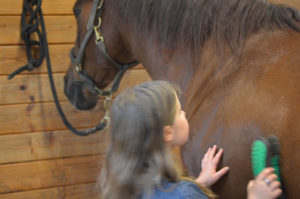 By Leigh Shambo, LPCC, HEAL Founder and Director
By Leigh Shambo, LPCC, HEAL Founder and Director
In the last few years, I’ve been pleasantly surprised to find articles found in equestrian journals that focus on the importance of “attachment” in the horse’s psyche. The term “attachment” (for family bonding) is a term from the study of human psychology. Until recently, some horsepeople still referred to imprinting (a process identified in geese), which spawned “imprint training” for foals, a process which did not resemble the natural nurturance between mare and foal! In the horsemanship world you may hear talk of “herd instinct”, “herd-bound” horses, and the ubiquitous training problem “barn-sour”.
Now we know with certainty (thanks to the work of animal scientist Jaak Panksepp) that the affective (feeling-based) brain systems of maternal bonding translate into patterns of adult social attachment. These neural pathways of emotional bonding and attachment, similar for all mammals and especially highly social mammals like horses and humans (yes, that’s right – we’re animals too!)
When viewed through the horsemanship lens, attachment is more likely to be viewed as a negative than a positive. Perhaps this indicates our society’s “attachment blindness”, as if somehow the horse shouldn’t need the safety and comfort that his herd represents. He should be fine on his own, right? Once we recognize the power of attachment, the remedy for many equine training “problems” is for the human to change, and become a more powerful figure of attachment and trust for the horse. The horses are extremely responsive to our affective changes – that’s what makes them good therapists!
A 2016 article in Equestrian Life by Dr Kerry Mack, called Horses and Attachment, describes the innate social bonding process as first introduced by psychiatrist and pediatrician John Bowlby in the 1950’s. The article stresses two points – that safe attachment is much different than simply being a strong leader; and that under stress mammals (esp highly social mammals) have one other option in addition to the well known “fight-flight-freeze” – highly social mammals will literally “cry for help” with an expectation of answer from the attachment figure. This article advocates a balance between being a leader and helping the horse feel safe, secure and trusting of us. We want to be the kind of leader our horse turns to, and can count on. http://www.equestrianlife.com.au/articles/horses-and-attachment#.WMDXjZpYTuA.email
 Author Christa Leste-Lasserre, MA the Horse Magazine (2013) cites leading equitation scientists, who say that both arousal (excitement, nervousness, and fear) and attachment (the calming presence of an attachment figure), play a role in the horse’s ability to learn. Horses that feel a closer attachment with their handler will feel more secure and confident. http://www.thehorse.com/articles/32311
Author Christa Leste-Lasserre, MA the Horse Magazine (2013) cites leading equitation scientists, who say that both arousal (excitement, nervousness, and fear) and attachment (the calming presence of an attachment figure), play a role in the horse’s ability to learn. Horses that feel a closer attachment with their handler will feel more secure and confident. http://www.thehorse.com/articles/32311
In HEAL therapy sessions, the activities may vary, but our focus is always on the attunement between human and horse. When a horses attachment needs are satisfied, most horses readily turn to help others – even when those others are humans! Many times, in therapy, the horse is the safe attachment figure for an inexperienced person. Horses offer a simple, pure and honest bond that can help humans learn about attaching – making bridges that help them connect with other humans!
